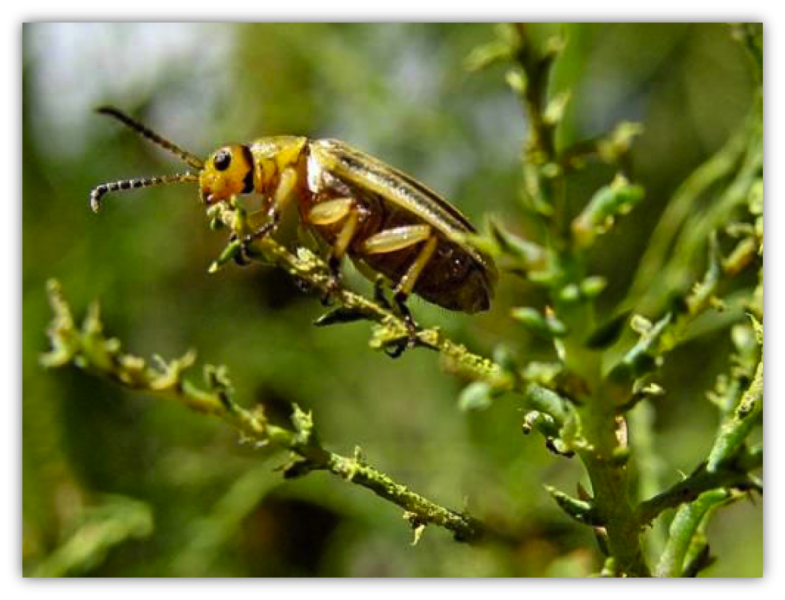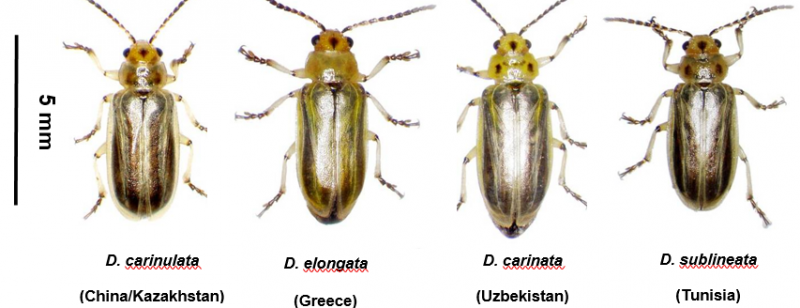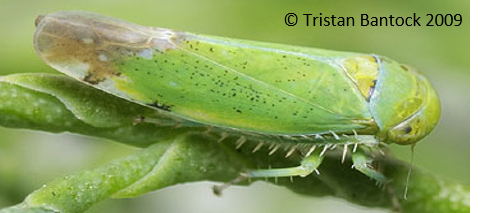Biological Control (Biocontrol) of Tamarisk in California
Many invasive plants come from other parts of the world without the herbivores that controlled them at home, allowing them to spread to become invasive weeds. Biological Control, or Biocontrol, is the importation of specialist organisms, usually insects, that feed ONLY on the target plant, with intent to suppress the weeds and allow native or desired plants to recover along with associated wildlife. This process essentially reunites invasive plants with their co-evolved herbivores from its native range. The expense and difficulty in controlling tamarisk using conventional control methods led biologists in the 1960s to develop a biological control program exploring the potential for biological agents that could control tamarisk.
 Tamarisk Leaf Beetles
Tamarisk Leaf Beetles
After over a decade of extensive testing overseas and in quarantine in the US, the tamarisk leaf beetle (genus Diorhabda) was chosen from over 300 specialist herbivores of tamarisk in the Old World for release in North America. This testing was used to determine that the tamarisk leaf beetles only eat tamarisk, are an effective agent in controlling tamarisk, and pose no threat to native plants or crops. Initial field releases were conducted in 2001.
The northern tamarisk leaf beetle (D. carinulata, pictured left) is now present along the Colorado River on the California border, and in the Owens Valley and the Mojave River. Three other Diorhabda species were also released in North America, one of which, Diorhabda elongata (Mediterranean), is present in northern California at Cache Creek.
D. carinulata from Fukang, China/Chilik, Kazakhstan (released May 2001); D. elongata from Greece (released August 2003); D. carinata from Uzbekistan (released July 2006); and D. sublineata from Tunisia (released July 2005). Only D. carinulata and D. elongata are present in the state of California.

James L. Tracy & Thomas O. Robbins - Taxonomic revision and biogeography of the Tamarix-feeding Diorhabda elongata (Brullé, 1832) species group (Coleoptera: Chrysomelidae: Galerucinae: Galerucini) and analysis of their potential in biological control of Tamarisk (Zootaxa 2101) 152 pp.; 30 cm. 11 May 2009
Ecosystem Responses
The different species of tamarisk leaf beetle tend to feed on select species of tamarisk; the adults and larvae feed by scraping the surface of the foliage, drying the tamarisk out. Beetles primarily feed and reproduce on the prefered species; in some cases they may feed on other tamarisk species, but often they move on before they can do any significant damage to the tree and they do not reproduce on these species. D. carinulata shows a preference for Tamarix ramossissima, T. chinesis, and hybrids. D. elongata shows a preference for T. parviflora.
Please see Invasive Species - Tamarisk for more information on tamarisk species.
When tamarisk is defoliated, water loss to the atmosphere is halted and instead is retained in the groundwater; annual water savings over 65% have been measured in some regions. Tamarisk initially re-grows after defoliation, but gradually dies back. Thus tamarisk is not eradicated, but it is suppressed, allowing space for native riparian plants like willows and cottonwoods to re-colonize the ecosystem. This process can be slow where years of environmental degradation makes recovery difficult, but active re-vegetation is being applied in some regions to jump-start the process. The beetles naturally decrease as tamarisk declines and native plants can re-colonize as space opens in the ecosystem. In some regions, birds and other wildlife have already been observed returning to restored native habitat.
While disruption of bird nesting IS possible, researcher from universities and public agencies that have closely monitored the biocontrol agents and ecosystem responses in other states shows the effect to be temporary. It is also key to initiate restoration activities early to jump-start native plant recovery and create conditions that favor a return to the natural ecosystem where needed.
Tamarisk Coalition 2016 - Beetle Distribution Map
Tamarisk Defoliation along the Colorado River in Needles, CA

Though Tamarisk has few natural enemies in North America, there are several insects that do feed on the plant in addition to the tamarisk leaf beetle;including the Tamarisk Leafhopper, the Splendid Tamarisk Weevil and several soft scale insects, Chinoaspsis estrusca and C. gilli.
 Opsius stactogalus (Tamarisk Leafhopper)
Opsius stactogalus (Tamarisk Leafhopper)
4-5 mm, leafhoppers are quite small and often found in large numbers. When leafhoppers have been feeding, Tamarisk foliage takes on a distinct yellow coloration.
 Coniatus splendidulus (Splendid Tamarisk Weevil) The splendid tamarisk weevil is know for its bright metallic coloring and the unique silk baskets it builds on tamarisk branches in which their larvae pupate. Interestingly enough, a similar species Coniatus tamarisci went through the TAG process and was approved for release at the same time as the tamarisk leaf beetle, but was never introduced in the field. Then, about 4 years ago, C. splendidulus showed up on a pecan weevil trap in Maricopa Co. (near Phoenix, AZ). Within a year of that initial trapping, C. splendidulus expanded rapidly to the Virgin River and has since expanded to the Colorado River, eastern California, New Mexico, and northern Mexico. Few studiest have been done on C. splendidulus but Dr. Zeynep Ozsoy of Colorado Mesa University has been testing for genetic markers within the population for which there has show to be very little variation, suggesting all popultions of C. splendidulus came from the same place in Arizona. While there is an outside chance the weevil was intentionally introduced, there is no evidence that it was nor any evidence that is was an escapee from the Texas USDA Agricultural Research Service lab where it was quarantine tested.
Coniatus splendidulus (Splendid Tamarisk Weevil) The splendid tamarisk weevil is know for its bright metallic coloring and the unique silk baskets it builds on tamarisk branches in which their larvae pupate. Interestingly enough, a similar species Coniatus tamarisci went through the TAG process and was approved for release at the same time as the tamarisk leaf beetle, but was never introduced in the field. Then, about 4 years ago, C. splendidulus showed up on a pecan weevil trap in Maricopa Co. (near Phoenix, AZ). Within a year of that initial trapping, C. splendidulus expanded rapidly to the Virgin River and has since expanded to the Colorado River, eastern California, New Mexico, and northern Mexico. Few studiest have been done on C. splendidulus but Dr. Zeynep Ozsoy of Colorado Mesa University has been testing for genetic markers within the population for which there has show to be very little variation, suggesting all popultions of C. splendidulus came from the same place in Arizona. While there is an outside chance the weevil was intentionally introduced, there is no evidence that it was nor any evidence that is was an escapee from the Texas USDA Agricultural Research Service lab where it was quarantine tested.
For more information on tamarisk invertebrates, please see our full guide in Resources
